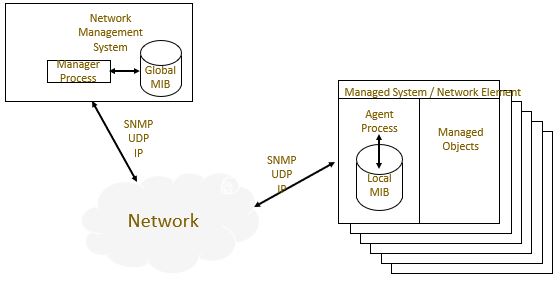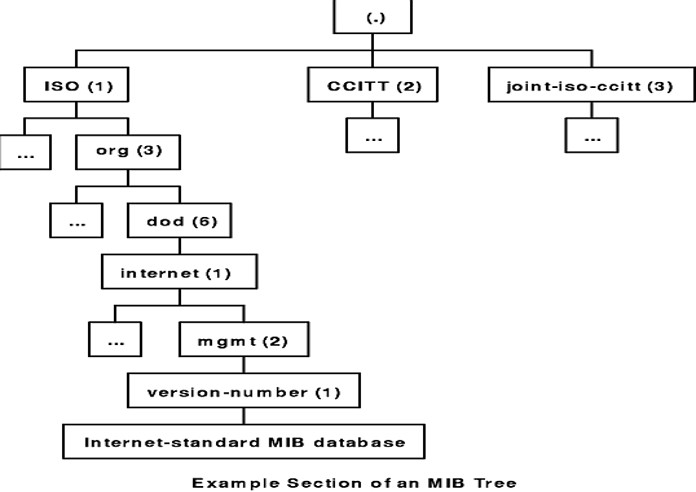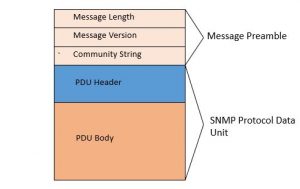Table of Contents
SNMP
SNMP (Simple Network Management Protocol) is a framework that provides facilities for managing and monitoring network resources on the Network.
SNMP is a standard produced by working groups within the IETF (Internet Engineering Task Force). It is published as a set of RFCs.
SNMP is more than a protocol. It is a management framework, including an architecture, an information model, management operations, etc.
Components of SNMP
- SNMP agents
- SNMP managers
- Management Information Bases (MIBs)
- SNMP protocol itself
Network Management Architecture

SNMP Components
- Follows the client server architecture
- Agents:
- Fully implements the SNMP protocol
- Stores and retrieves the management information’s as defined by MIB
- Asynchronous signal events to the manager
- Can be proxy for some other non-snmp device.
- Manager:
- Implemented as NMS
- Implements full SNMP protocol
- Able to
- Query agents
- Get response from agents
- Set variables on agents
- Acknowledge asynchronous events from agent
MIB – Management Information Base
- Management Information is modeled as (managed) objects and relationships among them.
- A MIB (Management Information Bases) is a collection of objects, grouped for a specific management purpose.
- All objects are organized in the global MIB tree.
- Each MIB represents a sub tree of this global MIB tree.
- The leaf objects of the tree contain object instances with the state and control variables of the managed system.
- MIB-II is the most popular MIB. It is implemented in most SNMP-managed devices.
- Device manufacturers often define their own device specific MIBs.
What is Managed Objects ?
- Each managed object is assigned an object identifier (OID)
- The OID is specified in a MIB file.
- An OID can be represented as a sequence of integers separated by decimal points or by a text string:
Example:
– 1.3.6.1.2.1.4.6.
– iso.org.dod.internet.mgmt.mib-2.ip.ipForwDatagrams
- When an SNMP manager requests an object, it sends the OID to the SNMP agent.
- Managed objects are organized in a tree-like hierarchy and the OIDs reflect the structure of the hierarchy.
- Each OID represents a node in the tree.
- The OID 1.3.6.1.2.1 (iso.org.dod.internet.mgmt.mib-2) is at the top of the hierarchy for all managed objects of the MIB-II.
- Manufacturers of networking equipment can add product specific objects to the hierarchy.
Management Information Base Tree

SMI, ASN.1 and BER
- Structure of Management Information (SMI)
- Defines set of rules used to specify the format for defining managed objects or the devices that are accessed using SNMP
- Abstract Syntax Notation One (ASN.1)
- The MIB modules and the SMI are expressed using a text based data description notation called as ASN.1
- ASCII text format
- Basic Encoding rules (BER)
- Encoding technique for SNMP MIB messages conveyed across the network
- Encoded in binary format
SMIv1 – Structure of Management Information
- SMIv1 is described in RFCs 1155, 1212, 1215
- These RFC Describes:
- How MIB modules are defined with CCITT X.208 ASN.1 data description language
- The subset of the ASN.1 language that is used in MIBs
- The addition of the APPLICATION data type to ASN.1, specifically for use with SNMP MIBs
- All ASN.1 constructs are serialized using the CCITT X.209 BER for transmission across the wire
- Definition of the high-level structure of the Internet branch (iso(1).org(3).dod(6).internet(1)) of the MIB naming tree
- The definition and description of an SNMP managed object
SMIv2 – Structure of Management Information
- SMIv2 is described in RFCs 1442, 1443, 1444
- These RFCs describes:
- SMIv2 is a backward compatible update to SMIv1
- The only exception is the Counter64 type defined by SMIv2
- Counter64 cannot be created in SMIv2
- RFC 2089 defines how bilingual (SMIv1 & SMIv2) agents handle the Counter64 data type
- IETF requires that new and revised RFCs specify MIB modules using SMIv2
SMI Data Types
| SMI V1 | SMI V2 | |
| Simple Types | Integer Octet String Object Identifier |
Integer Octet String Object Identifier Integer32 |
| Application Types | – Gauge Counter – Time Ticks IpAddress Opaque NetworkAddress |
Unassigned32 Gauge32 Counter32 Counter64 Time Ticks IpAddress Opaque – |
| Pseudo Types | – | Bits |
ASN.1 – Abstract Syntax Notation One
- ASN.1 is nothing more than a language definition. It is similar to C/C++ and other programming languages.
- Defining Objects
- Syntax
- Access
- Status
- Description
- Index
- value
BER – Basic Encoding Rules
- The relationship between ASN.1 and BER parallels that of source code and machine code.
- CCITT X.209 specifies the Basic Encoding Rules
- All SNMP messages are converted / serialized from ASN.1 notation into smaller, binary data (BER)
- Each ASN.1 value is encoded as octet string

- This encoding results into a sequence of tag, length & value
SNMP & OSI MODEL
| 7 | Application Layer | SNMP Management and Agent APIs |
| 6 | Presentation Layer | ASN 1.1 and BER |
| 5 | Session Layer | RPC and NetBIOS |
| 4 | Transport Layer | TCP and UDP |
| 3 | Network Layer | IP and IPX |
| 2 | Data Link Layer | Ethernet, Token Ring, FDDI |
| 1 | Physical Layer |
Basic Message Format
SNMP Versions
Three versions are in use today:
- SNMPv1 (1990)
- SNMPv2c (1996)
- Adds “GetBulk” function and some new types
- Adds RMON (remote monitoring) capability
- SNMPv3 (2002)
- SNMPv3 started from SNMPv1 (and not SNMPv2c)
- Addresses security
- All versions are still used today
- Many SNMP agents and managers support all three versions of the protocol.
SNMP Standards
- SMI
- Structure Of Management Information
- SMIv1 is defined by RFC1155,RFC1212 and RFC1215
- SMIv2 RFC1902, RFC1903 and RFC1904
- MIB-I and MIB-II
- Management Information Base
- MIB-I was the first version issued as 1156
- MIB-II RFC 1213
- A large number of additional MIBs exist
- SNMP V1
- Simple Network Management Protocol
- RFC 1155,1157
- Name is used in a more general sense
- SNMPv2c
- RFC 1901, 1906
- & SNMPv3
- RFC 1905, 1906, 2271, 2272, 2274 and RFC 2275
For Reference
http://www.ietf.org
http://searchnetworking.techtarget.com
http://docwiki.cisco.com/wiki/Simple_Network_Management Protocol
Network Management: Principles and Practice By Mani Subramanian
Essential SNMP, 2nd Edition by Douglas Mauro, Kevin Schmidt



